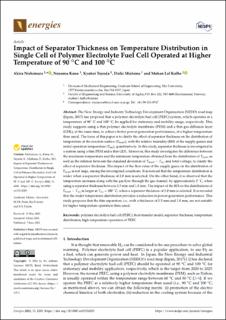| dc.contributor.author | Nishimura, Akira | |
| dc.contributor.author | Kono, Nozomu | |
| dc.contributor.author | Toyoda, Kyohei | |
| dc.contributor.author | Mishima, Daiki | |
| dc.contributor.author | Kolhe, Mohan Lal | |
| dc.date.accessioned | 2022-08-12T08:15:53Z | |
| dc.date.available | 2022-08-12T08:15:53Z | |
| dc.date.created | 2022-06-12T18:19:40Z | |
| dc.date.issued | 2022 | |
| dc.identifier.citation | Nishimura, A., Kono, N., Toyoda, K., Mishima, D. & Kolhe, M. L. (2022). Impact of Separator Thickness on Temperature Distribution in Single Cell of Polymer Electrolyte Fuel Cell Operated at Higher Temperature of 90 °C and 100 °C. Energies, 15 (12). | en_US |
| dc.identifier.issn | 1996-1073 | |
| dc.identifier.uri | https://hdl.handle.net/11250/3011534 | |
| dc.description.abstract | The New Energy and Industry Technology Development Organization (NEDO) road map (Japan, 2017) has proposed that a polymer electrolyte fuel cell (PEFC) system, which operates at a temperature of 90 °C and 100 °C, be applied for stationary and mobility usage, respectively. This study suggests using a thin polymer electrolyte membrane (PEM) and a thin gas diffusion layer (GDL), at the same time, to achieve better power-generation performance, at a higher temperature than usual. The focus of this paper is to clarify the effect of separator thickness on the distribution of temperature at the reaction surface (Treact), with the relative humidity (RH) of the supply gasses and initial operation temperature (Tini), quantitatively. In this study, separator thickness is investigated in a system using a thin PEM and a thin GDL. Moreover, this study investigates the difference between the maximum temperature and the minimum temperature obtained from the distribution of Treact as well as the relation between the standard deviation of Treact − Tini and total voltage, to clarify the effect of separator thickness. The impact of the flow rates of the supply gases on the distribution of Treact is not large, among the investigated conditions. It is noticed that the temperature distribution is wider when a separator thickness of 2.0 mm is selected. On the other hand, it is observed that the temperature increases along with the gas flow through the gas channel, by approximately 2 °C, when using a separator thickness between 1.5 mm and 1.0 mm. The impact of the RH on the distributions of Treact − Tini is larger at Tini = 100 °C, when a separator thickness of 1.0 mm is selected. It is revealed that the wider temperature distribution provides a reduction in power-generation performance. This study proposes that the thin separators, i.e., with a thickness of 1.5 mm and 1.0 mm, are not suitable for higher temperature operation than usual. | en_US |
| dc.language.iso | eng | en_US |
| dc.publisher | MDPI | en_US |
| dc.relation.uri | https://www.mdpi.com/1996-1073/15/12/4203/htm | |
| dc.rights | Navngivelse 4.0 Internasjonal | * |
| dc.rights.uri | http://creativecommons.org/licenses/by/4.0/deed.no | * |
| dc.title | Impact of Separator Thickness on Temperature Distribution in Single Cell of Polymer Electrolyte Fuel Cell Operated at Higher Temperature of 90 °C and 100 °C | en_US |
| dc.title.alternative | Impact of Separator Thickness on Temperature Distribution in Single Cell of Polymer Electrolyte Fuel Cell Operated at Higher Temperature of 90 °C and 100 °C | en_US |
| dc.type | Peer reviewed | en_US |
| dc.type | Journal article | en_US |
| dc.description.version | publishedVersion | en_US |
| dc.rights.holder | © 2022 The Author(s) | en_US |
| dc.subject.nsi | VDP::Matematikk og Naturvitenskap: 400::Geofag: 450 | en_US |
| dc.source.volume | 15 | en_US |
| dc.source.journal | Energies | en_US |
| dc.source.issue | 12 | en_US |
| dc.identifier.doi | https://doi.org/10.3390/en15124203 | |
| dc.identifier.cristin | 2031172 | |
| cristin.qualitycode | 1 | |

